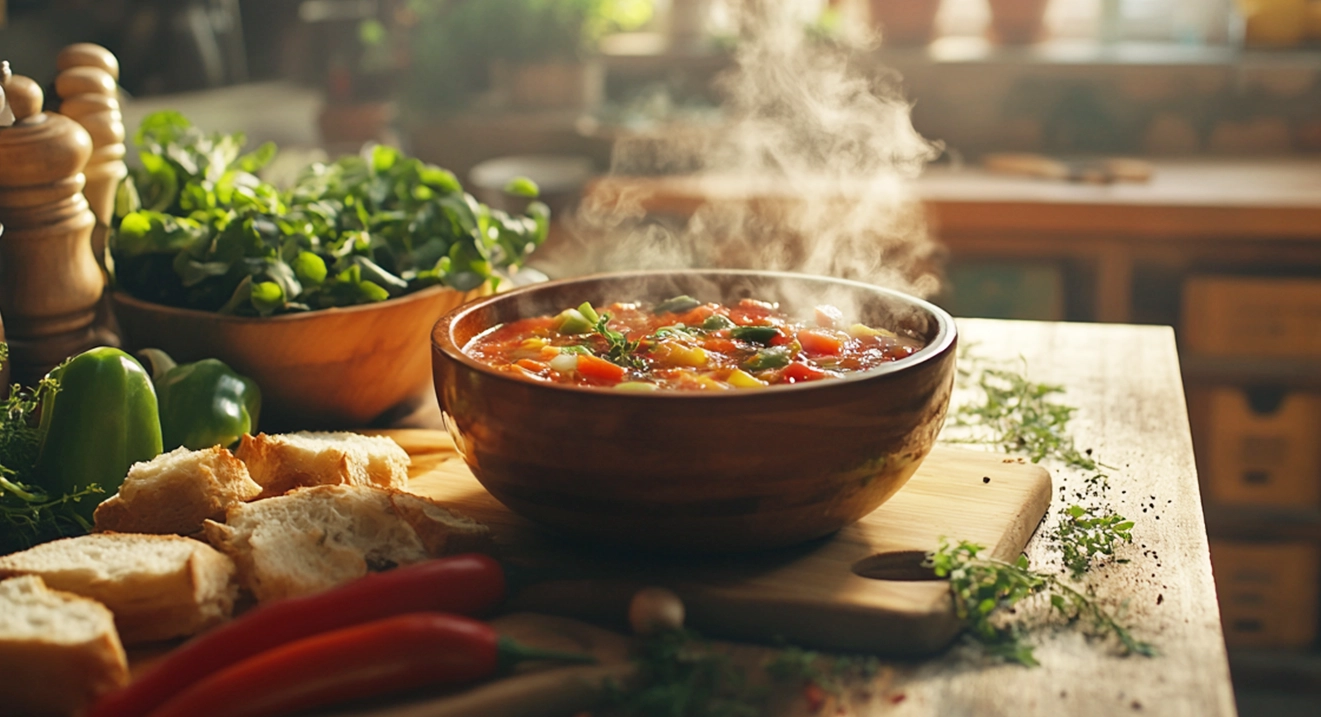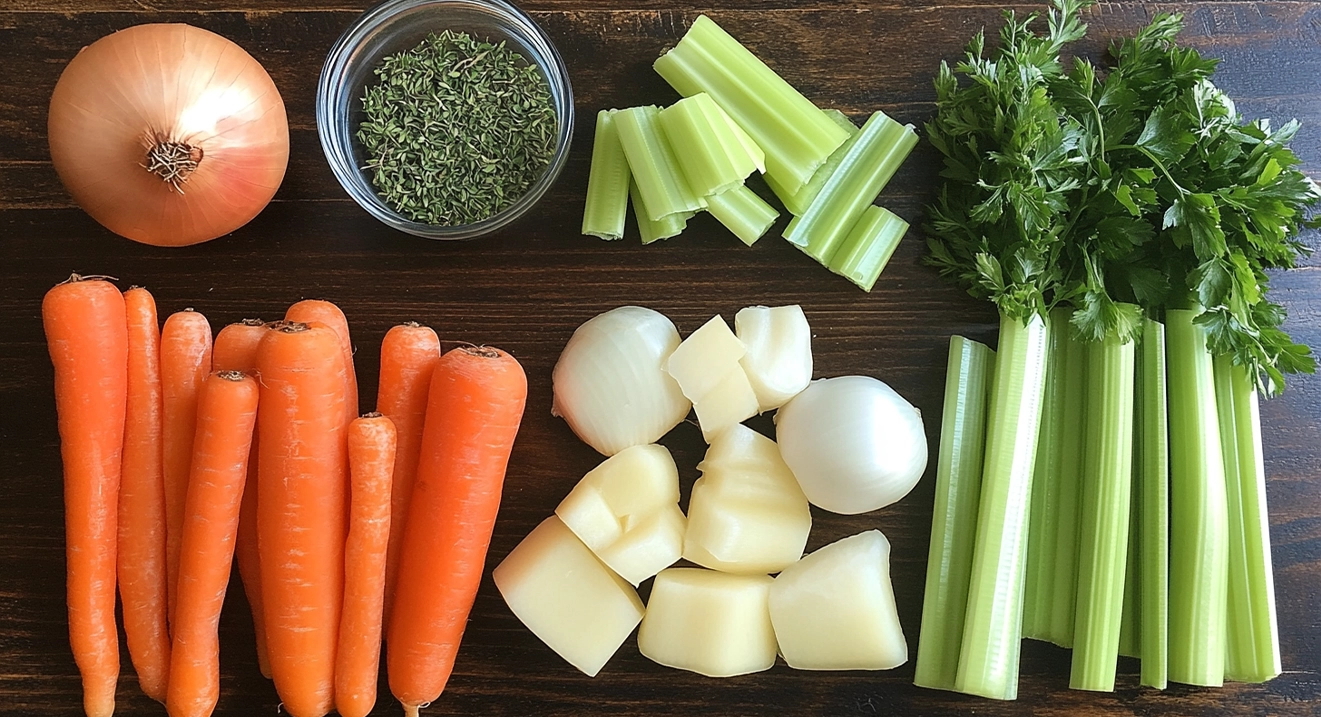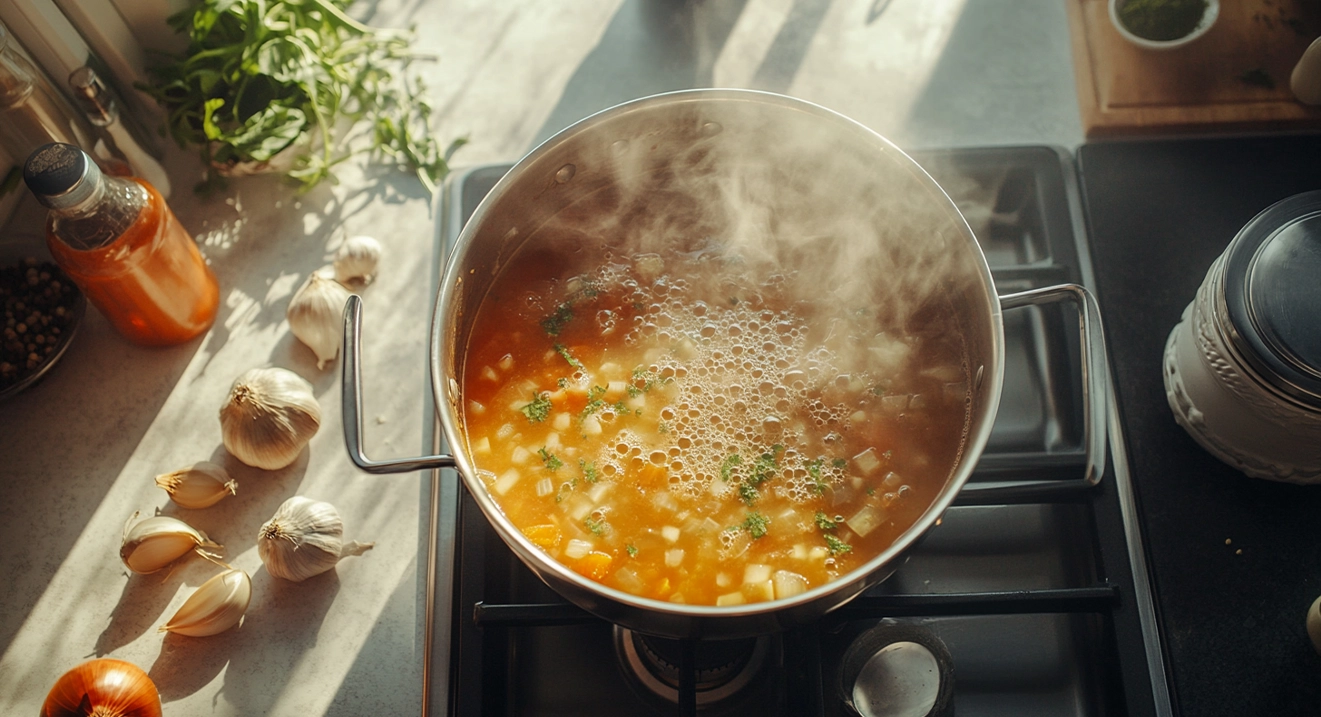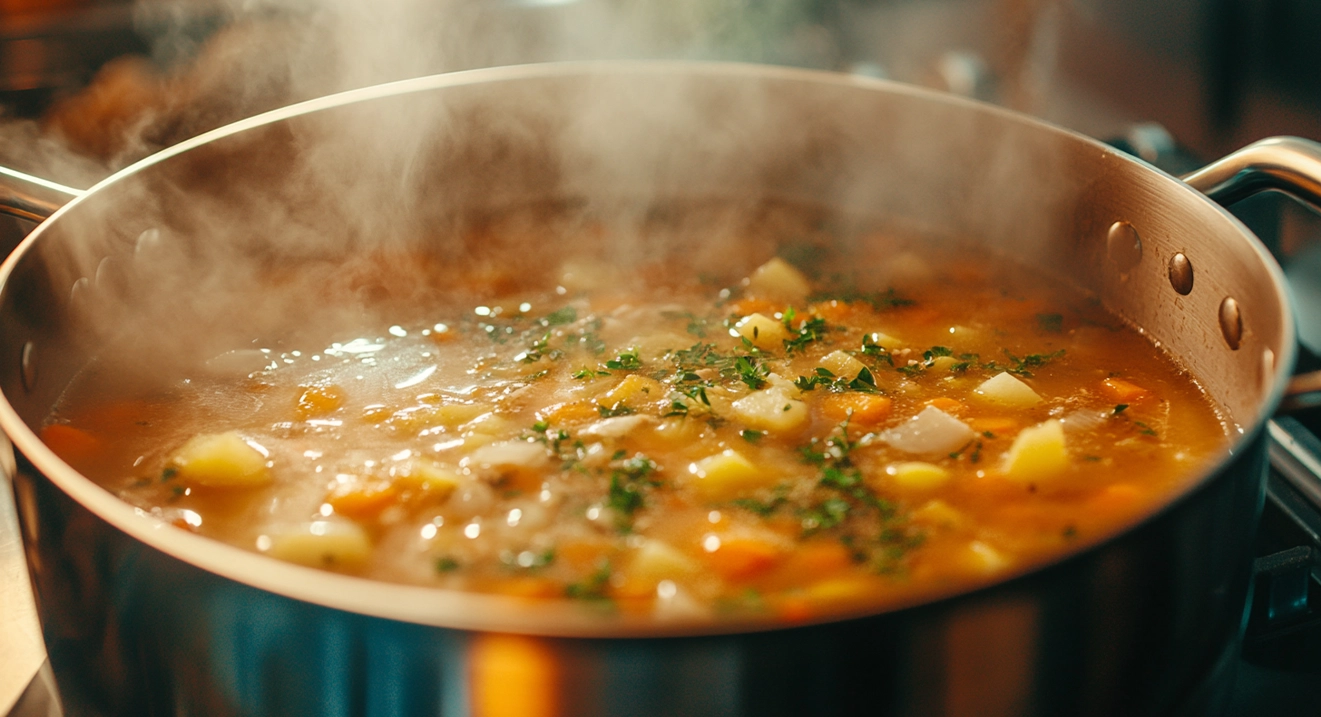How to Make the Perfect Homemade Soup: Tips, Techniques, and Creative Variations

Introduction to Homemade Soup
The Joy of Homemade Soup
There’s something incredibly comforting about a bowl of homemade soup. Whether it’s the warmth on a chilly day or the satisfaction of knowing exactly what’s in your dish, homemade soups bring a sense of accomplishment and love to the table. The aroma that fills your kitchen as you simmer fresh ingredients is an experience that store-bought versions can’t match.
Why Making Your Soup is Better Than Store-Bought
When you make your soup, you have complete control over the quality of ingredients, flavors, and textures. Homemade soup are fresher, healthier, and free from preservatives and artificial additives commonly found in store-bought varieties. You can customize the recipe to suit your dietary needs and preferences. The love and attention you put into preparing your soup make it a special dish that’s more nourishing, both for the body and soul.
Overview of Key Ingredients for a Great Homemade Soup
The foundation of any great homemade soup starts with fresh, high-quality ingredients. Essential ingredients like vegetables, herbs, and seasonings form the base of many soups. A good stock or broth—whether chicken, beef, vegetable, or a plant-based alternative—adds depth and richness. Aromatics like garlic, onions, and leeks elevate the flavor, while fresh herbs like thyme, rosemary, and parsley add an extra layer of fragrance. Don’t forget the importance of seasoning with salt and pepper to bring all the flavors together. With the right combination, your homemade soup will be delicious and satisfying.
Choosing the Right Ingredients

Fresh Vegetables vs. Canned: Which is Better?
Fresh vegetables are often the best choice for homemade soup, as they provide a vibrant, natural flavor and a better texture when cooked. Fresh produce is also preservative-free and highly nutritional than canned vegetables. However, canned vegetables can be convenient and cost-effective, especially for specific varieties that may not be available year-round. If you choose canned vegetables, look for low-sodium options to keep your soup healthier.
The Importance of Quality Broth
The broth or stock is the backbone of most soups, providing depth and flavor. Using homemade broth, made from scratch with bones or fresh vegetables, is ideal because it’s rich in nutrients and adds a complexity that store-bought versions can’t match. If using store-bought broth, choose high-quality options with minimal added salt and preservatives. You can always enhance the flavor of store-bought broth by simmering it with fresh herbs or aromatics for a more robust taste.
How to Pick the Right Protein for Your Soup
The protein you choose depends on the type of soup you’re making. Consider chicken, beef, or pork for a hearty, filling soup. For lighter soups, seafood, turkey, or plant-based proteins like lentils, beans, or tofu are great options. The key is to select a protein that complements the flavors of the broth and vegetables. Be sure to cook and season your protein correctly to enhance the overall taste and texture of the soup.
The Role of Herbs and Spices in Elevating Flavor
Herbs and spices are crucial in bringing complexity and brightness to your soup. Fresh herbs like thyme, rosemary, and bay leaves add aromatic depth, while spices like cumin, paprika, or turmeric can introduce warmth and earthiness. Be mindful of when you add herbs and spices during cooking—some, like bay leaves, are better simmered for a long time, while delicate herbs like parsley or basil should be added at the end to maintain their freshness. The right combination of herbs and spices will make your soup memorable.
Building the Perfect Base
- Choosing Between Stock, Broth, and Water
The base of your homemade soup is essential for developing a rich and flavorful dish. Stock, broth, and water all serve as the foundation, but they each bring something different. Stock is made by simmering bones, meat, or vegetables for an extended period, resulting in a thicker, more gelatinous texture and a deeper, more complex flavor. The broth is similar but typically made by simmering meat and vegetables without the bones, offering a lighter consistency. Water, on the other hand, is a neutral base that will rely heavily on added seasonings and ingredients to build flavor. For a more robust soup, it’s best to use stock or broth, as they provide more depth and richness than water.
Why a Strong Base is Crucial to Soup Flavor
A strong base acts as the backbone of your homemade soup, infusing every ingredient with flavor. Without a flavorful base, your soup may taste bland or one-dimensional, no matter how delicious the other ingredients are. The base sets the tone and harmonizes all of the flavors in your soup, making it a cohesive and satisfying dish. A good base will enhance the natural flavors of vegetables, proteins, and seasonings, ensuring your soup is as tasty as possible.
How to Make a Flavorful Homemade Stock
Making homemade stock is a simple process but requires time and patience. Begin by roasting bones (such as chicken, beef, or pork) and vegetables (like onions, carrots, and celery) in the oven to caramelize them and bring out their natural sweetness. Then, transfer them to a large pot, add cold water (about 4-5 cups), and bring to a simmer. Add herbs such as thyme, rosemary, bay leaves, and a couple of garlic cloves and peppercorns. Allow the stock to simmer for at least 2-3 hours, skimming off any foam that rises to the top. Once the stock has reduced and taken on a rich flavor, strain out the solids, leaving you with a flavorful liquid base to build your soup. Store any leftover stock in the fridge or freezer for future use.
Mastering Texture in Your Soup
The Difference Between Smooth and Chunky Soups
The texture of your soup can completely change the experience of eating it. Smooth soups are typically pureed to a velvety consistency, often creating a luxurious mouthfeel. These soups showcase delicate ingredients like vegetables, beans, or seafood. Chunky soups, on the other hand, feature larger pieces of vegetables, meats, and grains, providing a heartier, more rustic texture. Both types have their merits, depending on the flavor profile and the comfort level you aim for in the dish.
How to Achieve the Perfect Soup Consistency
Achieving the right soup consistency comes down to balance. You can thin your soup out with additional stock, broth, or water if it is too thick. If it’s too thin, consider adding ingredients like potatoes, beans, or grains that can naturally absorb liquid and add body. The key is to adjust gradually, adding liquid or thickening agents a little at a time and stirring frequently until the desired texture is reached. Remember that soups will thicken slightly as they cool, so be careful not to over-thick during cooking.
Thickening Your Soup Naturally: Using Flour, Cream, or Pureeing
There are several ways to thicken your soup naturally, each adding its unique flavor and texture:
- Flour: A classic method is to make a roux (a mixture of flour and fat) and stir it into your soup. This method works well for creamy soups or stews, adding both thickness and richness.
- Cream: Adding cream or milk to your soup can lend a smooth, velvety texture while also enriching the flavor. This is especially effective in vegetable-based soups like butternut squash or potato leek.
- Pureeing: Pureeing a portion of your soup, either with a blender or immersion blender, is a fantastic way to thicken the broth while maintaining a fresh flavor naturally. For example, pureeing cooked potatoes or beans can provide a creamy texture without adding dairy or flour. Additionally, using a hand blender in the pot allows you to control the smoothness of the soup while leaving some chunky elements for added interest.
Cooking Techniques to Improve Your Soup

Simmering vs. Boiling: Why Low Heat is Your Friend
When making soup, simmering is generally the best method over boiling. While boiling can cause ingredients to break down too quickly and become mushy, simmering allows the flavors to develop gradually. Simmering is done at a lower temperature, just below boiling, usually around 180-200°F (82-93°C). This gentle heat helps meld the flavors of your ingredients without overcooking them. It also allows the broth to extract the maximum flavor from herbs, spices, and proteins, resulting in a more well-rounded and delicious soup.
The Importance of Time in Cooking Your Soup
Patience is key when making soup. The longer you allow your soup to simmer, the more time the flavors have to develop and deepen. While it might be tempting to rush the process, giving your soup time to cook slowly will enhance the overall taste. For example, a slow-simmered beef stew or chicken soup can reach its full flavor potential after a few hours, as the ingredients have time to release their natural flavors into the broth. On the flip side, overcooking can lead to the loss of delicate flavors, so finding the right balance between time and heat is essential.
How to Avoid Overcooking Delicate Ingredients Like Greens
Greens, such as spinach, kale, or Swiss chard, are often added to soups toward the end of cooking. If overcooked, these delicate ingredients can lose their vibrant color, flavor, and nutrients. To avoid this, add the greens in the final 5 to 10 minutes of cooking, allowing them to wilt enough to incorporate into the soup without becoming mushy. For firmer greens like kale, a slightly longer cooking time may be required, but always taste as you go to ensure they retain their texture and freshness. Being mindful of timing will keep your soup colorful and full of fresh, vibrant flavors.
The Finishing Touches
Garnishes That Add Flavor and Visual Appeal
Garnishes are the perfect way to elevate your homemade soup flavor and presentation. Fresh herbs like parsley, cilantro, or basil add a burst of color and provide a refreshing contrast to the soup’s richness. Consider topping your soup with crispy croutons, roasted nuts, or seeds for added texture. A sprinkle of grated cheese, such as Parmesan or cheddar, can provide a savory, melty finish. You can also drizzle a little olive oil or a swirl of cream for a touch of elegance. Garnishes make your soup look more inviting and can enhance the flavor with complementary ingredients.
How to Use Cream, Yogurt, or Cheese to Enhance Texture and Taste
Cream, yogurt, or cheese can be transformative in soups, adding richness, smoothness, and depth of flavor. A splash of cream at the end of cooking creates a velvety texture, especially in vegetable-based soups like tomato or pumpkin. Yogurt offers a tangy contrast, making it an excellent choice for spiced soups like lentil or curry-based varieties. A dollop of yogurt or sour cream on top can also provide a cool, creamy counterpoint to spicy or hot soups. Cheese, whether melted into the soup or used as a garnish, adds flavor and texture. Grated cheese like Parmesan or feta can add sharpness, while creamy cheeses like goat cheese or mascarpone bring smoothness and richness.
The Final Seasonings to Add Just Before Serving
Seasoning at the end of cooking is crucial for achieving the perfect balance of flavors. After your soup has simmered and the ingredients have melded, taste it and adjust the seasoning with salt and pepper as needed. You can also add a squeeze of fresh lemon juice or a dash of vinegar to brighten the flavors and provide a touch of acidity. A pinch of cayenne pepper or a dash of hot sauce can give some heat if your soup feels flat. Fresh herbs, like chopped basil or cilantro, can be sprinkled on just before serving for an added burst of freshness. The final seasonings help round out the flavors, ensuring your soup is perfectly balanced and ready to enjoy.
Creative Variations of Homemade Soup
International Soups to Try for Variety and New Flavors
Exploring international soups is a great way to introduce new flavors and ingredients into your cooking. For example:
- French Onion Soup – A rich, savory soup made with caramelized onions and beef broth, topped with a melted cheese crouton.
- Tom Yum – A Thai soup known for its bold flavors, with lemongrass, lime, chili, and shrimp in a tangy, aromatic broth.
- Minestrone – An Italian vegetable and bean soup, often served with pasta and fresh herbs.
- Pho – A Vietnamese noodle soup with fragrant broth, rice noodles, and a combination of herbs and meat (typically beef or chicken).
- Borscht – A Ukrainian beet-based soup, often served hot or cold, rich in flavor and color, with a tangy-sweet taste.
These international soups offer a delightful change from traditional recipes, introducing you to new cooking methods, spices, and ingredients to keep your soups exciting.
How to Make Your Soup Vegan or Gluten-Free
Making your soup vegan or gluten-free is easier than you might think. For a vegan version, ensure you use plant-based ingredients like vegetables, legumes, tofu, or tempeh as the protein source. Swap out animal-based stocks for vegetable broth, and use non-dairy or coconut milk for creamy textures. Many classic soups, like lentil or vegetable soup, can be made vegan by omitting meat or dairy ingredients. For a gluten-free soup, avoid wheat-based thickeners like flour and use alternatives such as cornstarch, arrowroot powder, or pureeing vegetables to naturally thicken the soup. Make sure to use gluten-free pasta or grains like rice or quinoa if they’re part of the soup. Always double-check labels on store-bought ingredients like broth and seasoning blends to ensure they’re free from gluten.
Tips for Creating a Seasonal Soup Menu
Creating a seasonal soup menu allows you to highlight the best ingredients each time of year. In spring, focus on fresh greens and light broths with peas, asparagus, and fresh herbs like mint or basil. In summer, enjoy refreshing chilled soups, such as gazpacho or cucumber soup, and feature vegetables like tomatoes, zucchini, and bell peppers. Winter soups should be cozy and filling, with ingredients like potatoes, beans, cabbage, and rich broths, perfect for warming up on cold days. Using seasonal produce enhances the flavor and helps you make the most of fresh, local ingredients while embracing the season’s flavors.

Frequently Asked Questions
How to Make Homemade Soup Taste Better?
To make the homemade soup taste better, start with a strong base like homemade stock or broth rather than water. Sauté your aromatics, such as onions, garlic, and herbs, at the beginning to build a flavorful foundation. Season your soup gradually, tasting and adjusting along the way. Don’t forget the power of acidity—adding vinegar or fresh lemon juice at the end can brighten the flavors. Lastly, enhance the texture and richness with ingredients like cream, yogurt, or a sprinkle of cheese, and consider adding fresh herbs or a garnish just before serving for extra depth.
What is the Secret to Making Good Soup?
The secret to making good soup is balancing the flavors and allowing the ingredients to meld. Start with a flavorful base (stock or broth), use fresh, high-quality ingredients, and season as you go. Let your soup simmer, not boil, to allow the flavors to develop. The right combination of texture— smooth, chunky, or creamy—can also elevate the dish. Don’t forget to finish your soup with fresh herbs, a touch of cream, or a squeeze of citrus to take it to the next level.
How Do You Fix Boring Soup?
If your soup tastes boring, try adding more seasoning. A pinch of salt or a dash of pepper can work wonders but don’t forget about other spices or seasonings like garlic powder, cumin, or paprika. You can also brighten the flavor with acidity, like a squeeze of lemon juice, vinegar, or even a splash of hot sauce. Consider adding a splash of soy, miso, or Worcestershire sauce to add depth. If the soup lacks richness, stir in a spoonful of cream, coconut milk, or butter. Fresh herbs added at the end can also make a big difference.
How to Enhance a Can of Soup?
First, check the seasoning and adjust it to your taste to enhance a can of soup. Adding freshly chopped herbs like basil, parsley, or cilantro can make the homemade soup feel more fresh and. A dollop of sour cream, yogurt, or a drizzle of olive oil will add richness and texture. Add sautéed vegetables, cooked beans, or leftover meats to make the soup heartier. Consider incorporating a splash of vinegar, soy sauce, or a sprinkle of cheese for added flavor. Topping with croutons, roasted nuts, or a sprinkle of chili flakes will give your canned soup a gourmet twist.
Conclusion
Homemade soup is a comforting and nourishing meal and an opportunity to explore your creativity in the kitchen. By choosing the right ingredients, building a flavorful base, and mastering essential cooking techniques, you can create a delicious and satisfying soup. Whether making a classic recipe or experimenting with international flavors, homemade soup allows you to tailor each dish to your taste preferences and dietary needs. Remember, the key to the perfect soup lies in patience, balance, and attention to detail, from the first simmer to the finishing touches. With these tips and techniques, you’re well on your way to creating soups that will delight and warm your family and friends. Enjoy the process, and don’t be afraid to get creative in the kitchen!
